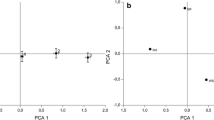Abstract
Thermoregulatory responses in the resting and the fasting states were studied from July to February in 20 White Leghorn laying hens in a hot-dry climate (41°C mean maximal summer temperature) and in 20 hens transferred in June from the hot-dry climate to a warm climate (30°C mean maximal summer temperature). The relationships of metabolic rates, skin and rectal temperature to ambient temperatures were similar in both climatic groups.
In both groups metabolic rates were 18% lower in summer than in winter. The thermal comfort temperature zone and rectal temperatures were significantly higher than those found in controlled climates. The relationship of metabolic rate to mean body temperature is suggested for defining the thermal comfort temperature zone.
Zusammenfassung
Die Thermoregulation von 20 weissen Leghorn Legehennen im Ruhe-und Nüchternzustand wurde in einem heiss-trocken Klima (41°C mittlere max. Sommertemperatur) untersucht und bei 20 Hennen, die im Juni aus einem heiss-trockenen in ein warmes Klima (30°C mittlere max. Sommertemperatur) überführt wurden. Die Beziehung zwischen Stoffwechselrate, Haut- und Rektaltemperaturen und Umgebungstemperaturen waren in beiden Klimagruppen gleich. In beiden Gruppen war die Stoffwechselrate im Sommer 18% niedriger als im Winter. Die Temperaturen der Komfortzone und die Rektaltemperaturen waren signifikant höher als in kontrollierten Klimaten. Es wird empfohlen, die Beziehungen zwischen Stoffwechselrate und mittlerer Körpertemperatur zur Definition der Komforttemperaturzone zu verwenden.
Resume
On a examiné les phénomènes de thermorégulation à l'état de repos et à jeûn de 20 poules pondeuses blanches Leghorn placées d'une part de juillet à février dans un climat très chaud et sec (41°C de max. moyen d'été) et d'autre part transférées en juin du climat très chaud et sec dans un climat chaud (30°C de max. moyen d'été). La relation entre le taux de métabolisme d'une part, la température de la peau et la température rectale d'autre part fut analogue dans les deux groupes. Dans les deux groupes, le taux de métabolisme fut de 18% inférieur en été à ce qu'il fut en hiver. La température de la zone de confort et la température rectale y furent plus ělevées, et cela de façon significative, que pour les bêtes maintenues en climat de contrôle. On propose d'utiliser la relation entre le taux de métabolisme et la température moyenne du corps pour définir la zone thermique de confort.
Similar content being viewed by others
References
BERMAN, A. (1968): Nychthemeral and seasonal patterns of thermoregulation in cattle. Austr.J.Agric.Res., 19: 181–189.
BERMAN, A. and SNAPIR, N. (1965): The relation of fasting and resting metabolic rates to heat tolerance in the domestic fowl. Brit.Poult.Sci., 6: 207–216.
BLAXTER, K.L. (1962): The Energy Metabolism of Ruminants. Hutchinson & Co., London.
CHANG, M.C. and FERNANDEZ-CANO, L. (1959): Effect of short changes of environmental temperature and low atmospheric pressure on ovulation of rats. Amer.J.Physiol., 196: 653–655.
COMPOS, A.C., WILCOX, F.H. and SHAFFNER, C.S. (1960): The influence of fast and slow rises in ambient temperature on production traits and mortality of laying pullets. Poult.Sci., 39: 119–129.
DUTT, R.H. (1963): Critical period for early embryo mortality in ewes exposed to high ambient temperature. J.Anim.Sci., 22: 713–719.
EDHOLM, O.G., FOX, R.H., ADAM, J.M. and GOLDSMITH, R. (1963): Comparison of artificial and natural acclimatization. Fed.Proc., 22: 709–715.
FOX, R.H., GOLDSMITH, R., HAMPTON, J.F.G. and HUNT, T.J. (1967):Heat acclimatization by controlled hyperthermia in hot-dry and hot-wet climates. J.appl.Physiol., 22: 39–46.
HARDY, J.D. (1965): The "set-point" concept in physiological temperature regulation. In: Physiological Controls and Regulations. W.S.Yamamoto and J.R.Brobeck (ed.), Saunders, New York.
KING, J.R. and FARNER, D.S. (1961): Energy metabolism thermoregulation and body temperature. In: Biology and Comparative Physiology of Birds. A.J.Marshall (ed.),Academic Press, New York.
MUELLER, W.J. (1961): The effect of constant and fluctuating environmental temperature on the biological performance of laying pullets. Poult.Sci., 40: 1562–1571.
OTA, H. and McNALLY, E.H. (1961): Poultry respiration calorimetric studies on laying hens. ARS 42–43, US Dept.Agric., Washington, D.C.
PAYNE, C.G. (1967): The influence of environmental temperature on egg production. In: Environmental Control in Poultry Production. T.C.Carter (ed.), Oliver and Boyd, Edinburgh.
SHANNON, D.W.F. and BROWN, W.O. (1969): The period of adaptation of the fasting metabolic rate of the common fowl to an increase in environmental temperature from 22°C to 29°C. Brit.Poult.Sci., 10: 13–18.
Author information
Authors and Affiliations
Rights and permissions
About this article
Cite this article
Berman, A., Heller, E.D. & Snapir, N. Thermoregulation in the domestic fowl exposed to a natural climate. Int J Biometeorol 13, 265–274 (1969). https://doi.org/10.1007/BF01553034
Received:
Issue Date:
DOI: https://doi.org/10.1007/BF01553034




